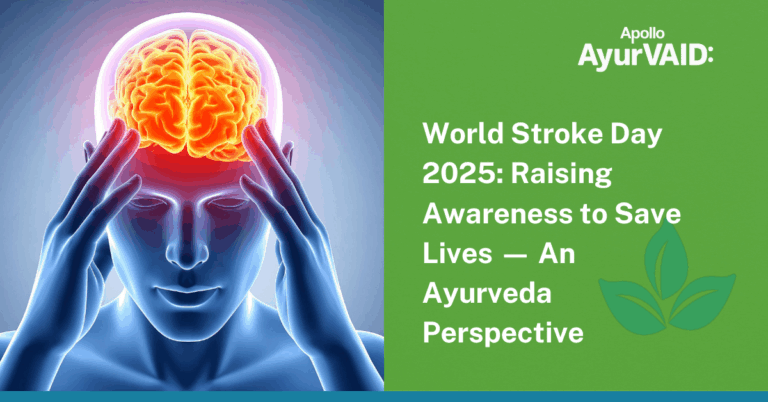Asthma affects about 339 million people globally. For many, the hardest part isn’t just the diagnosis – it’s the daily struggle to manage it. That’s why World Asthma Day is so important.
Observed every year on the first Tuesday of May, World Asthma Day brings global attention to asthma, helping people better understand it and find improved ways to manage their symptoms. The theme for World Asthma Day 2025 – “Make Inhaled Treatments Accessible for ALL”- emphasises the need for equal access to life-saving inhalers and medications because breathing should never be a privilege.But here’s the thing – while medications remain vital, many are also exploring natural asthma relief remedies to reduce triggers and prevent flare-ups. Ayurveda considers Asthma as Tamaka Shwasa – an imbalance of Prana Vata, and Kapha dosha. In this blog, we will explore how to prevent asthma attacks with the help of Ayurveda and complement your ongoing treatment for better outcomes.

What Are the Early Signs of Asthma?
- Breathlessness or wheezing, regardless of the intensity of physical activity
- A persistent wheeze, particularly during the evening and while lying down
- A sensation of abdominal pressure or constriction
- Frequently occurring coughing episodes, particularly in a cold climate or following physical activity
If you notice any of these, it’s time to speak to a doctor. In the initial phase, Tamaka Shwasa is considered Sadhya (curable), but it can progress to Yapya (manageable but not curable) in the event of a chronic condition or if it is not treated promptly.
Symptoms
- Shwasakricchra: Difficulty in breathing.
- Kasa: Persistent or recurrent coughing.
- Ghurghuruta: Wheezing sound.
- Breathing becomes more laboured when the patient lies flat.
- The patient feels relief and breathes more easily while sitting.
How to Prevent Asthma Attacks Naturally
Triggers like dust, smoke, pollen, and even stress can lead to asthma attacks. That’s the frustrating part – many triggers are hiding in plain sight. The good news? You can reduce many of them by making a few lifestyle changes, which is the first and foremost step in preventing asthma attacks as per Ayurveda – Nidana parivarjana. Here are some effective habits to lower the risk of asthma flare-ups:
- Keep your surroundings dust-free and well-ventilated
- Use air purifiers or open windows when the outdoor air quality is better
- Avoid smoking, incense, or strong fragrances indoors
- Stay physically active, but skip outdoor workouts when air quality is poor
- Add herbs like tulsi, black pepper to your diet. The application of oil infused with camphor can help relieve chest congestion in the early stages.
- Cut down on processed and cold foods, as they increase Kapha or mucus
- Practice breathing techniques or mindfulness to improve lung capacity and handle stress better
These steps won’t replace your inhaler, but they can help you prevent the onset of an asthma attack.
Can Ayurveda Offer Natural Asthma Relief?
Let’s be clear—Ayurveda doesn’t claim to “cure” asthma. But it offers tools to strengthen the respiratory system and reduce triggers. Its approach is preventive, focusing on balance and long-term health. Ayurveda outlines a comprehensive and sequential treatment strategy for Tamaka Shwasa:
- Nidana Parivarjana: Eliminate all causative and triggering factors to prevent aggravation of Doshas and worsening of the condition.
- Shodhana (Purification Therapy): Poorvakarma and Panchakarma therapies like Snehana (Oil therapy), Swedana (Steam therapy), Vamana (Induced emesis) to expel vitiated Kapha, Dhoomapana (Herbal smoke therapy) post-Vamana to remove residual toxins, and Virechana (Purgation) to clear lower channels and balance Doshas.
- Shamana (Palliative Therapy): Used in physically weaker individuals, children, and the elderly. It includes Agnideepana (digestive stimulants), Kapha-Vata balancing herbs, and Pranavaha Srotas-purifying regimens.
- Brimhana & Rasayana Chikitsa: Restore strength and immunity, especially in chronic or recurrent cases. These therapies rejuvenate tissues and help prevent future attacks.
- Asthma lifestyle changes include Aushadhis (formulations) designed to support lung function and reduce inflammation, Pranayama (yogic breathing) that improves lung capacity and relaxes the nervous system, and Ahara (Dietary adjustments) that include spices such as pepper, ginger, cumin, etc in the diet. Eliminating triggers like Ruksha Bhojana (consuming dry and rough food), Sheetavata Sevana (exposure to cold wind), Bharavahana (carrying heavy loads), Ativyayama (excessive physical exertion), and Vegadharana (suppressing natural urges) is essential to prevent Dosha aggravation.
At Apollo AyurVAID, these evidence-based treatments are customised to your body type and history, integrating traditional knowledge with modern medical understanding. For those dealing with asthma, especially chronic cases, Ayurveda can serve as a supportive tool, not a substitute. Each of these therapies, along with natural remedies for asthma, is tailored to your needs and complements your current medical treatment.
Bringing It Together: Why Both Approaches Matter
Modern medicine has given us inhalers, bronchodilators, and emergency treatments that save lives. But it doesn’t have to stop there. Combining this with preventive, natural remedies for asthma can make asthma management more sustainable. That means fewer flare-ups, less anxiety around breathing, and better quality of life. And Ayurveda fits right into that picture. Its strength lies in looking at the whole person – what you eat, how you breathe, how you sleep – and finding ways to support your body from within. For example, something as simple as avoiding late-night snacking or making sure your food is warm and freshly cooked can help reduce inflammation and mucus buildup.
Looking Ahead on World Asthma Day
So what’s the takeaway? This World Asthma Day, we’re reminded of the importance of access. To inhalers, yes. But also to information. To support. To complementary systems like Ayurveda that encourage prevention and mindfulness.
Breathing may be automatic, but for some, it isn’t effortless. Whether you’re just learning about asthma or have been managing it for years, there’s always something new to explore. At Apollo AyurVAID, we’re committed to helping you integrate Ayurveda wisdom into your life safely, thoughtfully, and with the guidance of experts. It’s never too late to find a new rhythm – one that helps you breathe with more ease and confidence.
Note: This blog is for educational purposes only. Always consult a healthcare provider before beginning any new treatment or supplement regimen.







